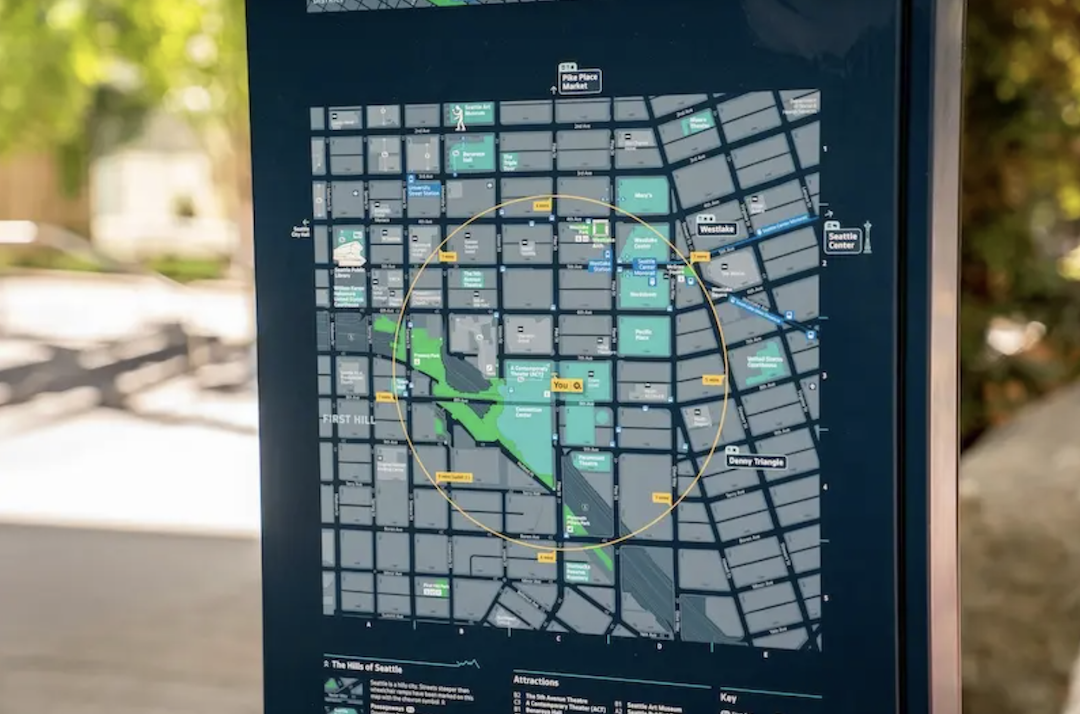The Seattle Department of Transportation (SDOT), in its attempt to make Seattle the most walkable and accessible city in America, has recently appointed Applied Information Group to create a citywide wayfinding system to encourage and enable more walking and rolling.
The system, dubbed Seamless Seattle, is based on the successful Legible London model, which is now lauded as the benchmark for complex city wayfinding. It will make America’s second-fastest growing city more legible and accessible for local residents, commuters, and the more than 40 million visitors that travel to Seattle each year.

Seamless Seattle will feature heads up mapping on street signs to help the user quickly orient themselves in reference to their immediate surroundings. Illustrations, slope information, accessible entrances to transit, and publicly accessible through building Hillclimb assists will all be integrated to meet the needs of the widest range of users. Braille and tactile panels provide orientation information on all signs and non-English languages in specific areas will be integrated as well.
In order to make the system as accessible as possible it will use proper contrast for legibility, optimization for color blindness, large type sizes, a careful balance of content, and simplification of complex topography.

Additionally, Seamless Seattle will adapt its design to respond to historic landmarked areas without reducing the overall legibility. Applied partnered with local businesses Alta Planning + Design and 3 Square Blocks to involve community and business leaders in the planning and design of the information system. Applied also worked closely with the major transit agencies Sound Transit and King County Metro to make sure a system of information for city streets is linked seamlessly to transit services.

“Our way finding project became much more than designing signs and directions,” said Adrian Bell, Applied’s Project Director for Seattle, in a release. “ The input of community leaders, stakeholders, and ambitious city staff encouraged us to create a project that is inclusive and demonstrates that walking, in particular, is the glue that holds the city together.”
Applied’s work with SDOT has so far produced an initial scoping study, a detailed planning strategy and guidelines, full design standards, and plans for two large pilot projects that will be implemented throughout the remainder of 2021.
Related Stories
AEC Tech | Feb 20, 2024
AI for construction: What kind of tool can artificial intelligence become for AEC teams?
Avoiding the hype and gathering good data are half the battle toward making artificial intelligence tools useful for performing design, operational, and jobsite tasks.
Sustainability | Nov 1, 2023
Researchers create building air leakage detection system using a camera in real time
Researchers at the U.S. Department of Energy’s Oak Ridge National Laboratory have developed a system that uses a camera to detect air leakage from buildings in real time.
75 Top Building Products | Aug 7, 2023
Enter today! BD+C's 75 Top Building Products for 2023
BD+C editors are now accepting submissions for the annual 75 Top Building Products awards. The winners will be featured in the November/December 2023 issue of Building Design+Construction.
Resiliency | Aug 7, 2023
Creative ways cities are seeking to beat urban heat gain
As temperatures in many areas hit record highs this summer, cities around the world are turning to creative solutions to cope with the heat. Here are several creative ways cities are seeking to beat urban heat gain.
AEC Innovators | Jun 15, 2023
Rogers-O'Brien Construction pilots wearables to reduce heat-related injuries on jobsites
Rogers-O'Brien Construction (RO) has launched a pilot program utilizing SafeGuard, a safety-as-a-service platform for real-time health and safety risk assessment. Non-invasive wearables connected to SafeGuard continuously monitor personnel to prevent heat exhaustion on jobsites, reducing the risk of related injuries. RO is the first general contractor to pilot this program.
Office Buildings | May 15, 2023
Sixteen-story office tower will use 40% less energy than an average NYC office building
This month marks the completion of a new 16-story office tower that is being promoted as New York City’s most sustainable office structure. That boast is backed by an innovative HVAC system that features geothermal wells, dedicated outdoor air system (DOAS) units, radiant heating and cooling, and a sophisticated control system to ensure that the elements work optimally together.
Design Innovation Report | Apr 27, 2023
BD+C's 2023 Design Innovation Report
Building Design+Construction’s Design Innovation Report presents projects, spaces, and initiatives—and the AEC professionals behind them—that push the boundaries of building design. This year, we feature four novel projects and one building science innovation.
Design Innovation Report | Apr 19, 2023
Reinforced concrete walls and fins stiffen and shade the National Bank of Kuwait skyscraper
When the National Bank of Kuwait first conceived its new headquarters more than a decade ago, it wanted to make a statement about passive design with a soaring tower that could withstand the extreme heat of Kuwait City, the country’s desert capital.
Design Innovation Report | Apr 19, 2023
HDR uses artificial intelligence tools to help design a vital health clinic in India
Architects from HDR worked pro bono with iKure, a technology-centric healthcare provider, to build a healthcare clinic in rural India.
3D Printing | Apr 11, 2023
University of Michigan’s DART Laboratory unveils Shell Wall—a concrete wall that’s lightweight and freeform 3D printed
The University of Michigan’s DART Laboratory has unveiled a new product called Shell Wall—which the organization describes as the first lightweight, freeform 3D printed and structurally reinforced concrete wall. The innovative product leverages DART Laboratory’s research and development on the use of 3D-printing technology to build structures that require less concrete.

















